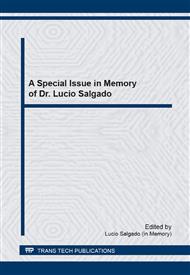[1]
J. Crane and J. Winter: Copper: Properties and alloying, Encyclopedia of Materials Science and Engineering (Ed. MB Bewer, Pergamon Press and the MIT vol. 2, 1986).
Google Scholar
[2]
P. W. Taubenblat: Copper Selection of high conductivity alloys, Encyclopedia of Materials Science and Engineering (Ed. MB Bewer, Pergamon Press and the MIT vol. 2 1986).
Google Scholar
[3]
H. W. Turner and C. Turner; Copper in electrical contacts, CDA publications 23, December 1980, Surrey, Great Britain, 1 – 22.
Google Scholar
[4]
ASM Specialty Handbook: Copper and Copper Alloys, Metal, chapter 1, section 1, ASM International, (2001).
Google Scholar
[5]
C. R. Brooks, Heat Treatment, Structure and Properties of Nonferrous Alloys, ed. ASM, Metals Park, 1988, chapter 8.
Google Scholar
[6]
A. Butts; Copper, the Science and Technology of the Metal, its Alloys and Compounds, ed. Reinhold Publishing Corporation, New York, 1954, 3th printing (1960).
Google Scholar
[7]
G. Gosh, J. Kiyake and M. E. Fine, JOM, March (1997), pp.56-60.
Google Scholar
[8]
A. Rotem, D. Shechtman, and A. Rosen: Metall. Trans. A Vol. 19 (1988), p.2279.
Google Scholar
[9]
D. Steiner, R. Beddoe, V. Gerold, G. Kostorz and R. Schmelczer: Scripta Metall., Vol. 17 (1983), p.733.
DOI: 10.1016/0036-9748(83)90483-0
Google Scholar
[10]
A. Guha, , " Development of a high-strength, high-conductivity Cu-Ni-Be Alloy, high conductivity Copper and Aluminum Alloys, eds. E. Ling and P. Taubenblat W., TMS – AIME Publ. 1984, pp.133-145.
Google Scholar
[11]
Y. Sakai, K. Inoue, and H. Maeda, Acta Metall. Mater. 43 (1995), p.1517.
Google Scholar
[12]
W. A. Monteiro, F. Cosandey and P. Bandaru, The Effect Of Thermomechanical Treatment On The Microstructure Of A Cu-Ni-Be Alloy, Proceedings of THERMEC'97, Wollongong, Australia, July (1997).
Google Scholar
[13]
W. A. Stadtler, Production of Metallurgy Parts. ASTM, Powder Metallurgy, Ohio, pp.449-463, (1989).
Google Scholar
[14]
M. Ghadiri, F. A. Farhadpour, , R. Clift, J. P. K. Seville, Particle characterization size and morphology, The Institute of Metals Series on Powder Metallurgy - An Overview. London, pp.56-75, (1991).
Google Scholar
[15]
Powder metallurgy - An overview. 1. Ed. The Institute of Metals Series on Powder Metallurgy, London, Great Britain, (1991).
Google Scholar
[16]
W. A. Kaysser, Solid State Sintering. The Institute of Metals Series on Powder Metallurgy - an overview. London, pp.45-53, (1991).
Google Scholar
[17]
F. Thümmler & R. Oberacker, Introduction to Powder Metallurgy, The Institute of Materials, 1993, ISBN 0-901716-26-X).
Google Scholar
[18]
G. K. WHITE, The Thermal and Electrical Conductivity of Copper at Low Temperatures, Australian Journal of Physics, vol. 6, p.397, (1953).
Google Scholar
[19]
R. P. REED and R. P. MIKESELL, Low Temperature Mechanical Properties of Copper and Selected Copper Alloys, NBS Monograph 101, Inst. for Materials Research, National Bureau of Standards, Boulder, Colorado 80302, (1967).
DOI: 10.6028/nbs.mono.101
Google Scholar
[20]
A. F. CLARK, and R. P. REED, Advances in Cryogenic Engineering, Materials, volume 30, Plenum Press, New York (1984).
Google Scholar
[21]
J. A. G. Carrió, W. A. Monteiro, V. A. Rodrigues, M. C. Terence, T. J. Masson, L. F. de Miranda, Structural analysis of influence of dopants in the electrical conductivity of CuNi alloys, European Powder Diffraction Conference – EPDIC 11, 19-22 September 2008, Warsaw, Poland.
Google Scholar


